Politics
The Art Industry Is Grappling With How to Shrink Its Carbon Footprint. But Will Collectors Do Their Part?
The carbon cost of shipping works for short-term events is art's dirty secret.
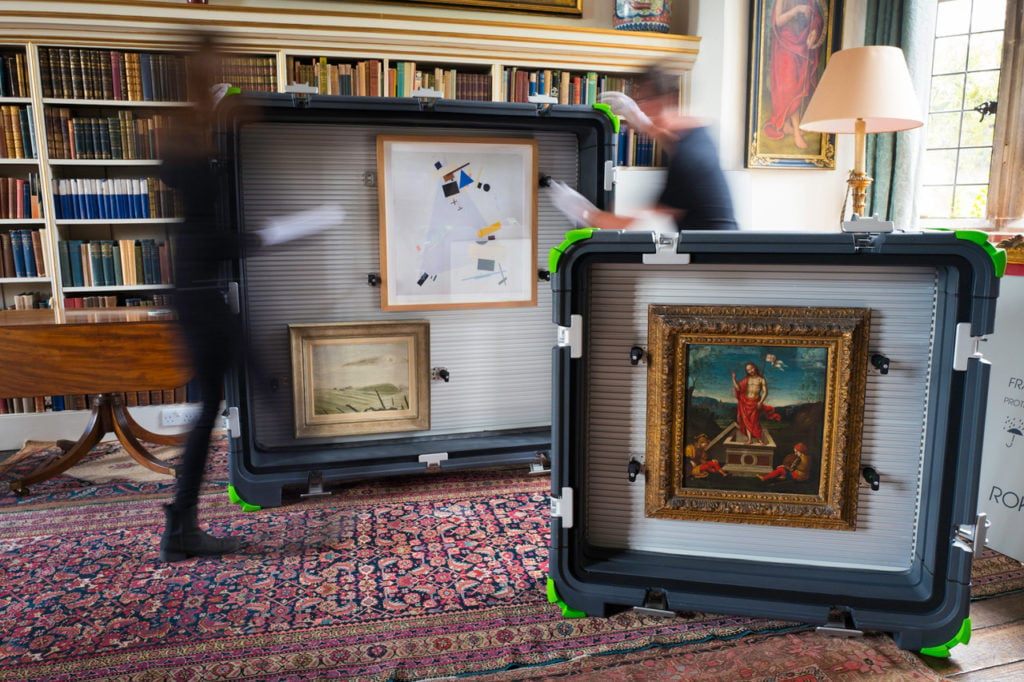
The carbon cost of shipping works for short-term events is art's dirty secret.

Kate Brown

This past Friday, hundreds of thousands of people marched around the world for the global climate strike. Around that same time, convoys of artworks crossed the Florida border for Art Basel Miami Beach, where they will stay for just under a week before being scooped up and shipped out again to various collectors’ storage nodes and homes around the world.
Despite the art world’s self-image as a socially conscious avant-garde, its structure is becoming increasingly untenable. Jet-setting from fair to fair is an obvious polluter (and the private jet travel preferred by collectors is by far the most polluting), but the shipping of artworks, which tends to be done by truck and air freight, is also a major culprit. Dietl International, a prominent shipping company, will generate 1,000 metric tons of carbon dioxide due to its shipment to Miami this year alone. For comparison, the average US car emits about 4.6 metric tons of carbon dioxide… in a year.
With this reality increasingly impossible to ignore, many in the art world are trying to make changes to the way they do business. Some artists are offering compelling work on themes dealing with the climate; galleries are trying to trim their waste and reuse where they can afford to; Art Basel Miami Beach will hold a symposium on how to respond to challenge climate-change denial this coming Saturday. Many members of the art industry have become vocal about the wastefulness woven into the very fabric of doing business in art. But where, exactly, are the collectors in our current wave of ecological awareness?
A reciprocal relationship exists between those who buy art and those who supply it. Greener alternatives are needed—but the art industry can’t always afford to make changes until collectors demand them.
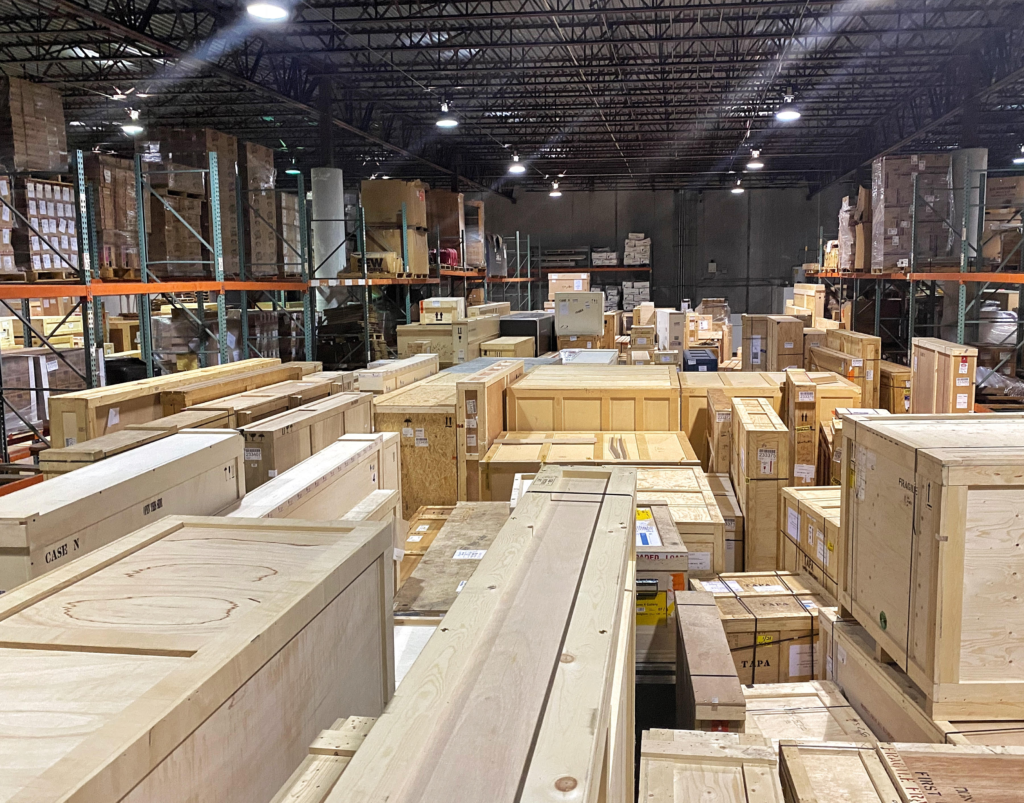
A look inside of one of Dietl International’s warehouses.
Up until now, there has not been any serious overhaul of the way galleries and art fairs—or even artists, save for a few—are delivering messages to collectors about sustainability.
“From a communications perspective, we know that people are motivated when they feel an issue and related action connects to and supports their identity and value system,” Christine Larivière, a climate change communications specialist, tells me. “Many economists—and others—believe climate action could be accelerated once the right financial incentives are put in place.”
However superficial transformation at the consumer level may be in the battle against climate change, rapidly changing customer choices offer some some modest good news: Single-use plastics have become intolerable to today’s vanguard and short-haul flights have become positively uncool. But, at the top end, shifting awareness and tastes is more than a matter of a few dollars.
“Buying art is expensive. When you first start collecting, it’s shocking just how expensive it is, in terms of shipping, insurance, and storage,” says Lisa Schiff, an art advisor who has been vocal about climate change. As one example of a proactive approach, I ask what she thinks about carbon neutralizing costs being tacked onto gallery invoices. She says that to work, such added fees would need to be buried in the price rather than presented as an additional cost.
“I know plenty of collectors who are huge environmentalists and who are changing the world, but when they’re buying art, that’s just not where he or she may be putting their energy,” Schiff says. She stresses that, in her mind, the onus is on galleries, the suppliers, rather than on collectors, their consumers.
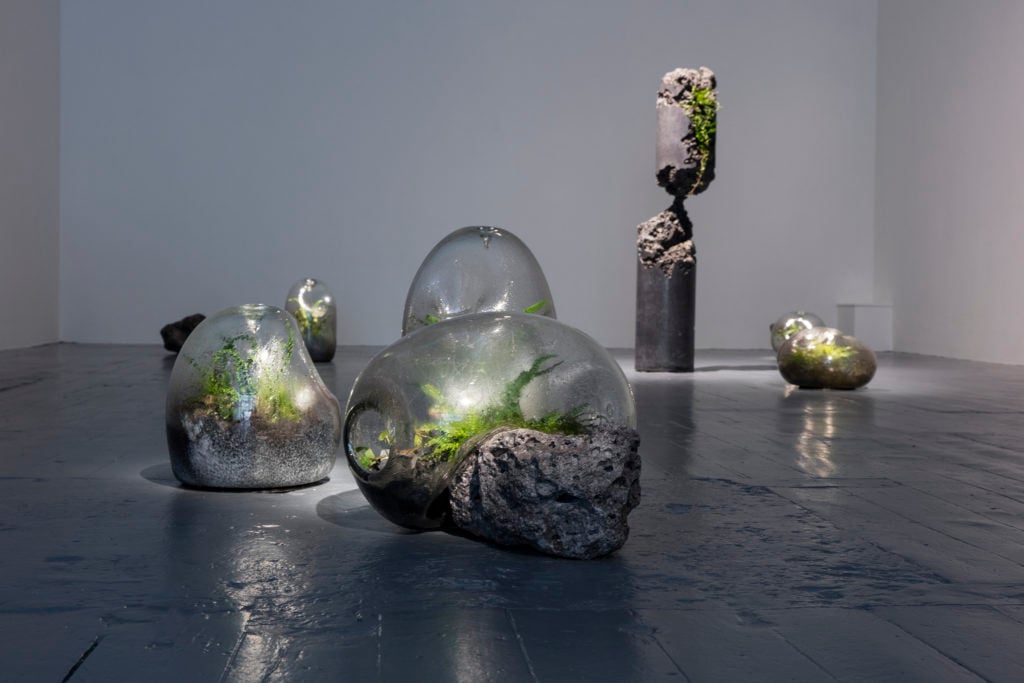
Installation view of Jamie North’s exhibition “Inflection” at Informality, London.
To be sure, consumers play a small role in the massive upheaval needed to slow the climate crisis, but they are nonetheless a force for change. Collectors are the ones who ultimately support all the ideas and objects being flashed across iPads at Art Basel. In turn, it should follow that their demands might incentivize galleries to make changes that would otherwise feel unwise in a very high-stakes market, especially for small to mid-range galleries with perilously thin profit margins.
“A lot of these conversations may move forward if started by the collectors,” says Bruno Brunnet, a veteran dealer and co-founder of Berlin’s Contemporary Fine Arts, who represents artists like Georg Baselitz and Huma Bhabha. But he admits that collectors have, so far, been mute on the subject: “We have not had any requests for greener shipping or hesitation to travel on sustainable grounds from any collectors, though these are conversations we would be open to.”
He’s far from the first gallery owner to tell me that. Some 15 art dealers said that not once had a collector inquired about more environmentally efficient shipping options and only a few had asked about reusable packaging.
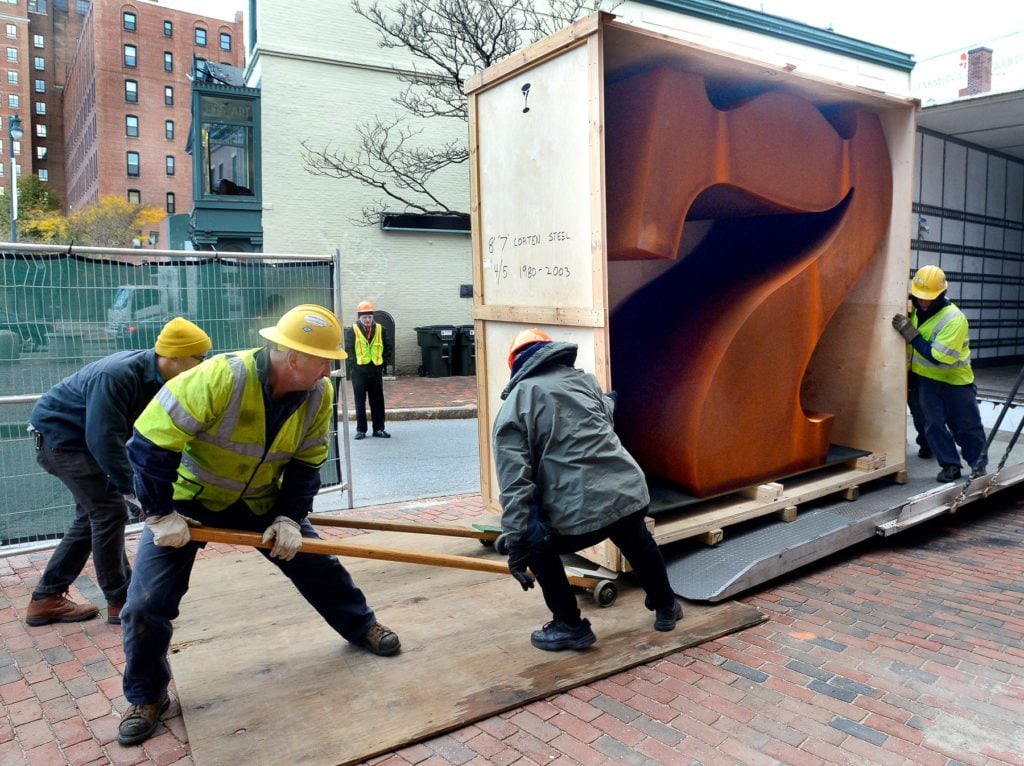
Workers remove the sculpture from its packing crate as the Portland Museum of Art installs an 8 foot tall steel “Seven” sculpture by Robert Indiana. Photo by John Patriquin/Portland Portland Press Herald via Getty Images.
You can worry about plastic straws at fair cafes and bleached paper press releases all you like, but shipping art around the world (and art-goers—but that’s a story for another day) may be art’s dirtiest secret.
“No one’s going to pay twice for an organic banana—to be sustainable, it has to be reasonably competitive,” Fritz Dietl tells me over the phone from New York. Dietl is president of the eponymous art shipping company Dietl International, one of the largest in the art industry. He is optimistic that his sector can become more sustainable, pending demand for more ecologically-minded shipping, which he says is growing. Ahead of Art Basel Miami Beach, Dietl’s team has organized a 747 charter to fly from Luxembourg directly to Miami, as opposed to going through Atlanta or New York, the usual art transportation route that requires more carbon dioxide-emitting ground travel.
Products like RokBox, a reusable crate that is lighter (and safer) than a wooden box, are also popping up. These can make a big difference. “The total weight of the combined shipments is approximately 60 tons. If all items had been packed in reusable lightweight RokBoxes the actual weight would have been reduced by about 20 tons,” says Dietl. “The CO₂ emissions would have been reduced by about 75 to 100 tons.”
Dietl is organizing about half the floor at Art Basel Miami Beach, so it’s crunch time when I talk to him. Still, he seems eager to take the time to parse out the details of CO₂ emissions in the art industry. “This is not something talked about a few years ago, and in the art world you’d be hard-pressed to find a climate change denier,” he says. “But this comes down to the bottom line: When we offer green solutions, we need to find cost-effective ones, especially for galleries who are on the edge of profitability.”
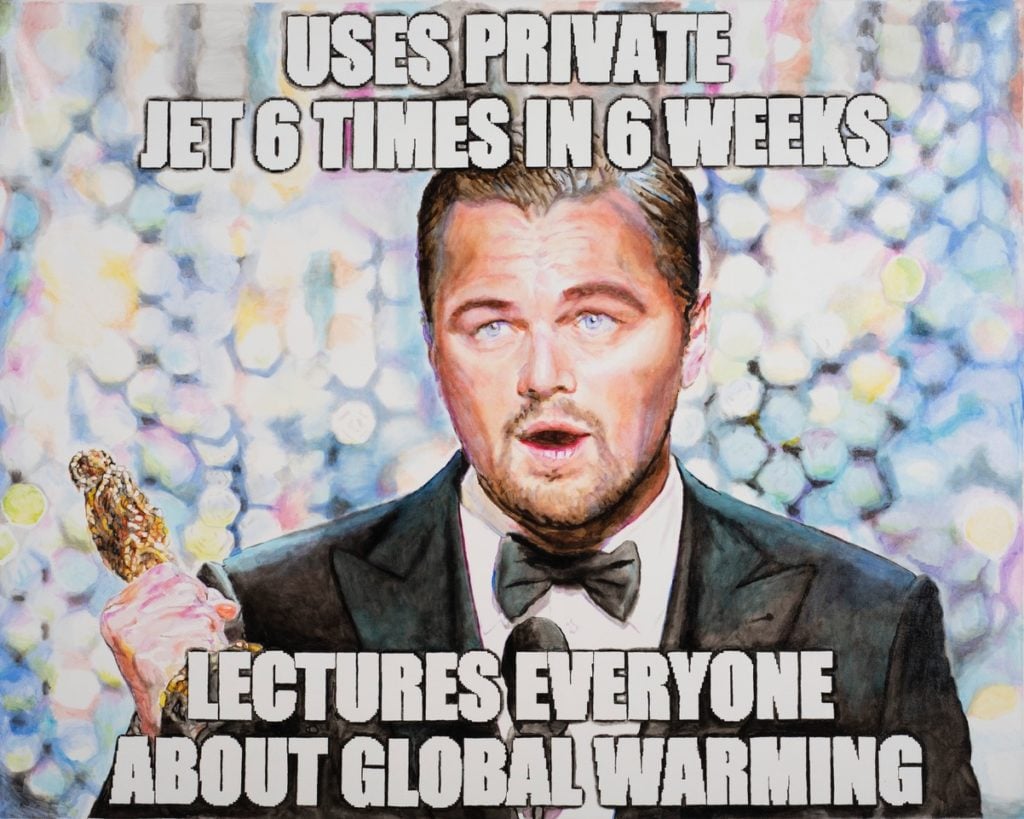
Christine Wang’s Oscar (2019). Acrylic on canvas. Courtesy Nagel Draxler.
Young galleries are just as concerned as larger and more established ones, despite concerns over expenses. Every gallery I spoke to expressed a sense of urgency about addressing the question of short-haul flights and short-term fair attendance, and discussed different ideas for how to minimize waste, from ditching bubble wrap to offering virtual exhibition spaces.
When it comes to shipping, most galleries seem unsure what the extra expenses might be and unaware of greener options, a point echoed by collectors as well (shipping costs for a purchased work are usually always covered by the collector). If that price is deemed prohibitive, then galleries, who tend to organize the shipping, pushing more expensive options could alienate clients. This is part of why the conversation has not yet made the leap from galleries’ offices onto the fair floor. Two collectors told me they had never been offered CO₂-neutral shipping options or alternatives to the usual disposable crate and air freight option.
The onus may then fall on the collector to ask for these numbers, but also on shipping companies to make clear what options are even available. It’s a feedback loop, but it needs to start somewhere. “I think that the collectors’ impact could be huge,” says Johannes Sperling, a young dealer from Munich. “Imagine them not flying around the globe anymore; or boycotting galleries that go too crazy when it comes to shipments and flights. It would also be possible to give better prices to galleries participating at art fairs who are not shipping tons of works around the globe.”
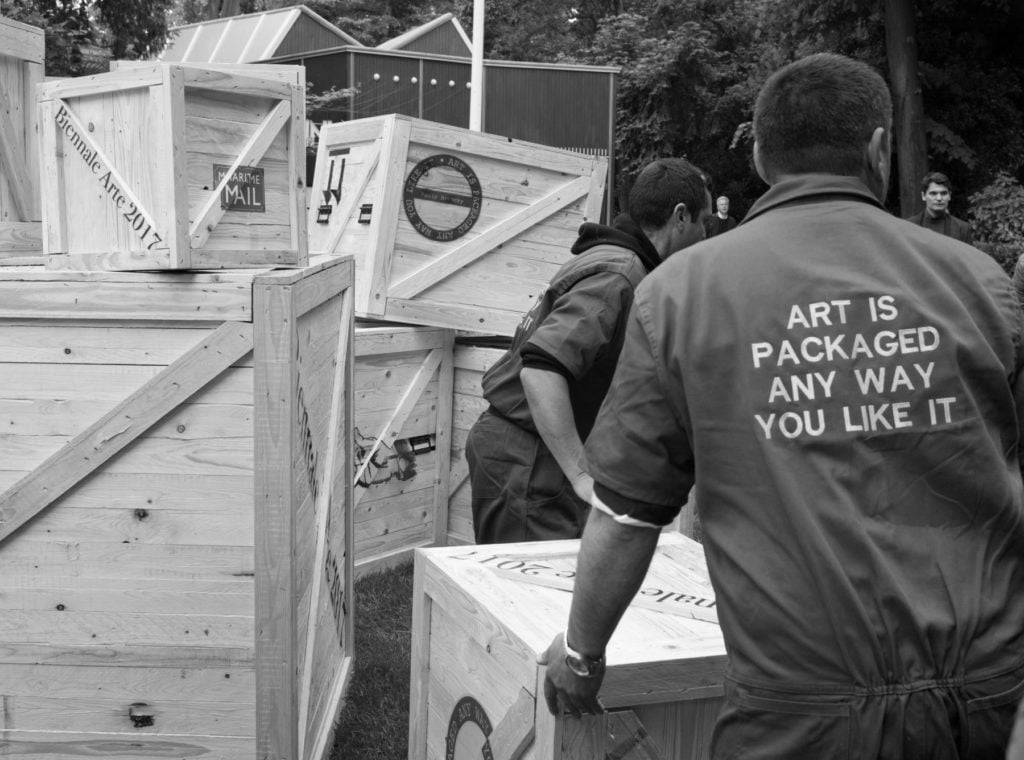
Workers transport wooden crates containing artwork at the Biennale Giardini on May 11, 2017 in Venice, Italy. Photo by Marco Secchi/Getty Images.
“We aren’t yet at the point where collectors expect any details from us related to our carbon footprint or how their acquisitions with the gallery might affect their own footprint,” says Thaddaeus Ropac. This year, his gallery invested in additional storage space so it can re-use bespoke crates that are typically disposed after each use; the shipping companies they work with, he notes, only share the carbon footprint after the shipment’s completion. “I’m aware that there will be additional costs incurred to get the results, but I’m willing to swallow this out of principle,” he says.
Dietl will be at the fair during the preview days meeting with clients, and greener shipping is going to be one of his talking points, encouraging his clients to get on board for his new carbon credits program, where they can offset their individual shipments and give funds directly to environmental projects. But he says it is harder to woo collectors on the subject, particularly because in the majority of cases once they own a work, the piece does not travel that much. Most of the shipping is to and from the fair, and not much beyond it, so reusable crates and CO₂-neutral considerations may not be the first concern that comes to mind.
Hopefully, with a little bit better branding, perspectives can be shifted and awareness raised about transport costs at every stage of an artwork’s life.
“To be honest, no, I never asked about [alternative shipping methods], mainly because I didn’t think that there would be an option,” collector Christian Kaspar Schwarm says. Still, as with other collectors I spoke to, even the suggestion of better choices brought an encouraging response. “I think I’ll ask for more sustainable shipping options in the future,” he concluded. “No industry should be too small to take care of our planet.”